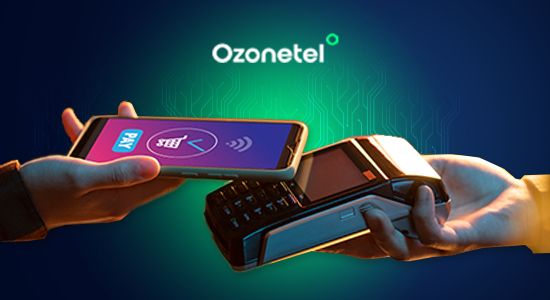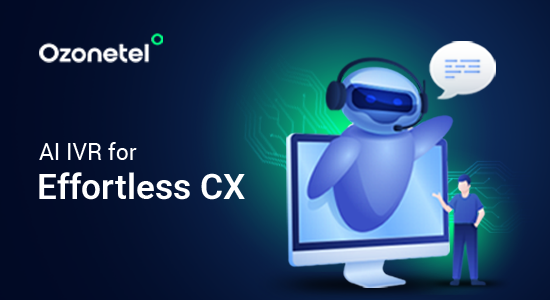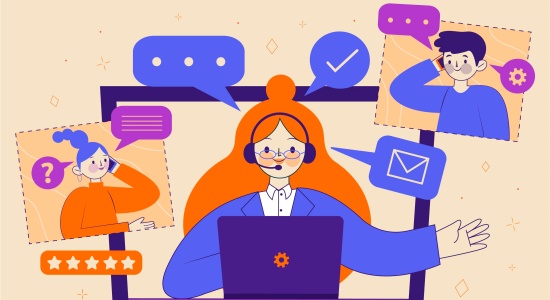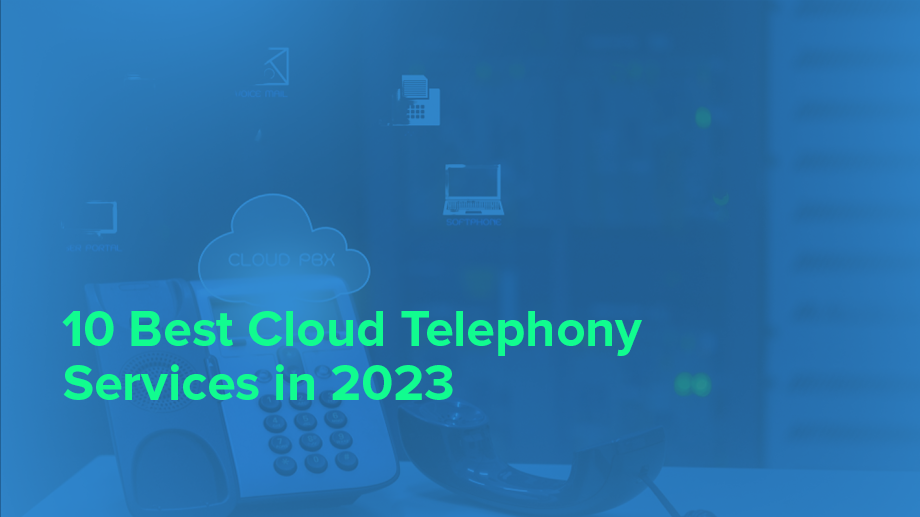- Resources
- 8 Powerful Chatbot Use Cases Across Industries
8 Powerful Chatbot Use Cases Across Industries

No one likes waiting, especially when they need quick answers. Whether it’s tracking an order, booking an appointment, or getting account help, customers expect instant responses. Long hold times and slow replies can lead to frustration and lost business.
This is where chatbots make a difference. They handle routine questions, provide 24/7 support, and speed up customer interactions, freeing up human agents for more complex tasks. Businesses across industries—from retail and healthcare to banking and travel—are using chatbots to improve efficiency and customer satisfaction.
In this article, we’ll explore eight chatbot use cases across different industries and how they improve efficiency, engagement, and customer satisfaction
What is Employee Experience?
Employee Experience (EX) is the overall perception employees have of their journey within an organization. It encompasses every interaction and touchpoint, from recruitment and onboarding to daily responsibilities, support systems, and eventual offboarding.
How Do Chatbots Work?
Chatbots are software programs designed to simulate human-like conversations. They process and respond to text or voice inputs, allowing businesses to automate interactions across multiple channels like websites, messaging apps, and social media. But how do they actually work?
1. Understanding User Input
Chatbots use Natural Language Processing (NLP) to interpret user queries. NLP helps break down language, recognize intent, and extract relevant information. Some bots rely on predefined rule-based responses, while more advanced ones use Machine Learning (ML) to improve over time by analyzing past interactions.
2. Processing the Request
Once the chatbot understands the query, it processes the request by:
- Matching the input with a predefined response (for rule-based bots)
- Fetching relevant data from databases or third-party systems (for transactional bots)
- Using AI models to generate dynamic responses (for GenAI-powered bots)
This step determines whether the bot can resolve the issue or if it needs to escalate the conversation to a human agent.
3. Generating a Response
After processing the request, the chatbot generates a response. Depending on its capabilities, it can:
- Provide text-based answers
- Trigger automated workflows (like booking an appointment or processing a refund)
- Transfer the conversation to a human agent with full context
Some bots even use Conversational AI, which goes beyond basic responses by understanding user sentiment and context to make interactions feel more natural.
Benefits of Using Chatbots
Chatbots have changed the way businesses interact with customers. They provide instant support, reduce workloads, and improve engagement. So if you’re considering adding a chatbot to your customer service, here’s how it can help.
Personalized Customer Experience
Customers expect chatbots to remember their preferences and make interactions more relevant. When integrated with your CRM (customer relationship management), marketing automation tools, or customer service platform, chatbots can:
- Adapt responses based on where a customer is in their journey.
- Recommend products or services based on past interactions.
- Provide order status updates without asking for order details.
- Remind customers about items left in their shopping cart.
This level of personalization makes interactions smoother and improves customer satisfaction.
Reduced Customer Requests for Agents
Chatbots handle common queries, reducing the number of requests that reach your support team. They can:
- Provide order tracking and status updates.
- Assist with returns, refunds, and payment issues.
- Answer frequently asked questions.
- Collect feedback after interactions.
This allows human agents to focus on complex issues, improving response times and service quality.
Faster Customer Engagement
Customers expect quick responses, and chatbots deliver. According to reports, 71% of customers believe chatbots help them get faster replies. Chatbots can:
- Send proactive updates about orders, payments, and service requests.
- Engage in real-time or hold ongoing conversations across channels.
- Automate appointment reminders and confirmations.
- Collect feedback immediately after interactions.
By keeping customers engaged, chatbots help businesses build stronger relationships.
24/7 Availability
Customers don’t just shop or ask questions during business hours. Chatbots provide round-the-clock support, ensuring customers get answers whenever they need them. Since 75% of consumers expect a response within five minutes, having a chatbot ensures no query goes unanswered, even outside of working hours.
Instant Responses for Better Customer Experience
Long wait times drive customers away. Chatbots eliminate this problem by responding instantly. Some chatbots use pre-set menus for FAQs (frequently asked questions), allowing users to find answers without even typing their questions. If more details are needed, the chatbot refines the query and provides a resolution within seconds. This reduces frustration and improves overall customer satisfaction.
Higher Customer Satisfaction and Retention
When customers get fast, accurate, and relevant responses, they are more likely to return. Chatbots help maintain a consistent level of service, ensuring every interaction is smooth and efficient. This directly impacts customer retention, as satisfied customers are more likely to stay loyal to a brand.
8 Chatbot Use Cases Across Industries
Chatbots have become an integral part of customer engagement, automating routine interactions and ensuring quick, efficient responses. Across industries, they help businesses handle high-volume queries, guide users through decision-making processes, and improve operational efficiency. Let’s look at some use cases of chatbots across different industries:
#1. Finance and Insurance

In finance, chatbots work by handling loan inquiries, payment reminders, fraud detection, and customer support. They provide real-time assistance for customers looking for information on gold loans, insurance policies, or investment plans. Additionally, chatbots help reduce wait times, improve compliance, and integrate with core banking systems for accurate, automated responses.
For example, Muthoot Gold leveraged a WhatsApp-based chatbot to create a phygital (physical + digital) customer experience, allowing users to browse jewelry collections and check inventory without visiting a branch. The chatbot, integrated with Muthoot’s ERP (Enterprise Resource Planning) system, ensures real-time catalog updates.
The impact?
- Customers can explore products, ask for gold loan details, and make purchase inquiries directly on WhatsApp.
- The chatbot provides instant responses, reducing dependency on call centers and branch visits.
- Muthoot’s approach led to a 2.5x increase in average order value and generated 150,000+ WhatsApp interactions.
#2. Hospitality
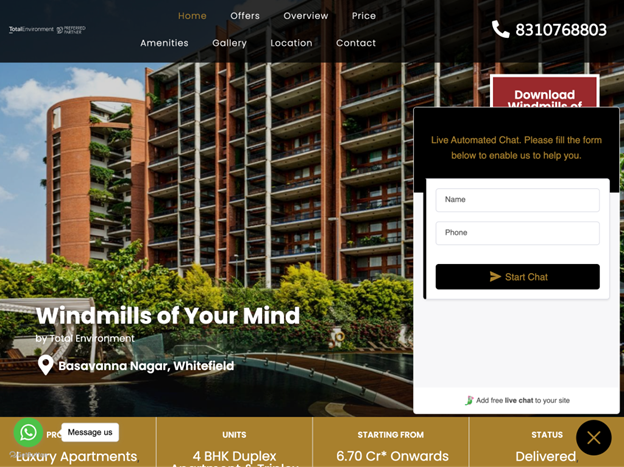
Chatbots in hospitality simplify reservations, assist in guest inquiries, and manage marketing campaigns. They help customers with real-time availability checks, personalized recommendations, and loyalty program updates. Businesses also use chatbots to gather customer preferences, allowing for tailored experiences that improve guest satisfaction.
For example, Total Environment adopted a WhatsApp chatbot to manage reservations for its brands, Windmills and Oota. The chatbot streamlines the booking process and integrates with the company’s CRM (Customer Relationship Management) system.
The impact?
- When a customer initiates a reservation, the chatbot determines whether it’s a personal or corporate booking.
- For personal bookings, it automatically completes the reservation without manual intervention.
- For corporate bookings, it collects details and routes them to the sales team.
This automation resulted in 10x faster customer validation, helping Total Environment improve efficiency and run targeted marketing campaigns. The chatbot’s impact contributed to a 22x ROI on marketing and 20% business growth.
#3. Machinery and Equipment

For industries like agriculture, manufacturing, and equipment sales, chatbots provide technical support, spare parts assistance, and post-sales service. Customers often struggle to find consistent and accessible product information, making chatbots a valuable tool for guiding purchase decisions and troubleshooting equipment issues.
For example, Mahindra Farm Machinery used WhatsApp as its primary communication channel, integrating a chatbot to engage with farmers. Since product information was scattered across multiple sources, the chatbot centralized product details, usage guidance, and service support.
The impact?
- Farmers can ask about equipment specifications, dealer locations, and spare parts availability directly on WhatsApp.
- The chatbot enables faster response times for service requests and customer queries.
- By analyzing inquiries, Mahindra improved its product demand forecasting and optimized marketing campaigns.
#4. Customer Service

Customer service teams often deal with a high volume of inquiries, which can lead to long wait times and inconsistent responses. AI chatbots solve this challenge by providing instant, round-the-clock support, handling common queries, tracking orders, resolving complaints, and offering personalized recommendations based on user history.
Chatbots also improve customer satisfaction and engagement by delivering quick, accurate responses without the need for human intervention. They integrate with CRM systems to access past interactions, allowing for a seamless and personalized experience.
For example, Kayak’s chatbot on Facebook Messenger helps travelers manage their trips effortlessly. It allows users to search for flights, book hotels, track reservations, and get real-time updates on flight changes—all through a simple chat interface. This reduces the need to navigate multiple platforms, making travel planning more convenient.
#5. Human Resource

HR departments often spend significant time screening candidates, scheduling interviews, and managing employee queries. Chatbots simplify these tasks by automating recruitment workflows, answering FAQs, and engaging with candidates in real-time.
For job seekers, chatbots create a more accessible and user-friendly application process by allowing them to apply via text, receive interview invites, and get instant updates on their application status. Internally, HR chatbots assist employees by handling requests related to leave policies, payroll, and benefits, reducing HR teams’ workload.
For example, Olivia by Paradox, an AI-powered HR chatbot, helps companies manage hiring efficiently. It allows candidates to apply for jobs via text, schedule interviews, and participate in video interviews—all without requiring human intervention. The chatbot also integrates with HR systems to streamline the recruitment process.
#6. Education

Education is evolving with AI-powered chatbots that make learning more engaging, interactive, and personalized. These bots assist students by answering questions, providing instant feedback, and adapting lessons based on individual learning progress.
Chatbots also help language learners practice conversations, assist students with homework, and provide study recommendations. Many educational institutions use AI chatbots to handle administrative tasks like course enrollment and deadline reminders, reducing the workload for teachers and staff.
For example, Duolingo’s AI chatbot, Lily, makes language learning more engaging. It offers real-time conversation practice with a sarcastic, Gen Z-friendly personality, keeping learners motivated. The “Video Call with Lily” feature helps users practice speaking in a realistic, interactive setting, making language learning feel natural.
#7. Legal Assistance

Law firms receive numerous inquiries daily, making it challenging to filter potential cases and respond to client requests promptly. AI chatbots help by collecting client details, answering basic legal questions, and directing users to relevant resources before involving a lawyer.
Legal chatbots improve efficiency by automating initial case evaluations, scheduling consultations, and ensuring compliance with data privacy regulations. This allows law firms to focus on complex, high-value cases while ensuring quick and accurate assistance for clients.
For example, Oikonomakis Law’s chatbot streamlines client intake through an AI-powered chat interface. When a visitor lands on their website, the chatbot collects key details about their legal issue, allowing the law firm to prioritize urgent cases and respond efficiently.
#8. Ecommerce
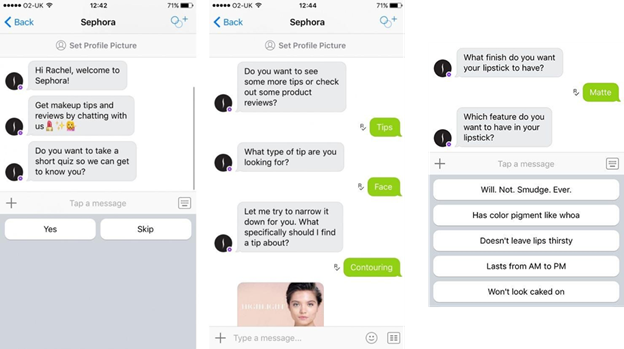
ECommerce brands use AI chatbots to enhance customer experience by assisting with product discovery, handling order tracking, and reducing cart abandonment. These bots provide personalized recommendations based on browsing history, answer product-related queries, and even help users find the perfect items through AI-powered image recognition.
Chatbots also streamline the booking of services, loyalty program management, and customer feedback collection, making shopping more interactive and convenient.
For example, Sephora’s chatbot improves the shopping experience with two AI-powered features:
- Sephora Reservation Assistant helps customers book beauty appointments at nearby stores by simply sharing their location in the chat.
- Sephora Color Match allows users to scan any color from an image and get product recommendations that match the shade, making it easier to find the perfect makeup.
The Future of Chatbots: From Automation to Autonomous AI Agents
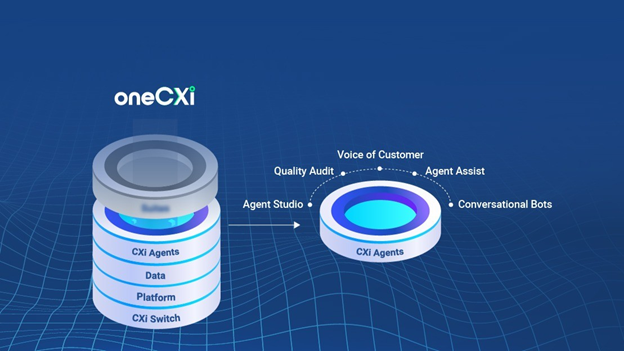
Chatbots have evolved from simple automation tools to intelligent agents that not only engage with customers but also orchestrate workflows across business processes. However, traditional AI solutions often fail to bridge the gap between insights and action due to fragmented enterprise systems. This is where autonomous AI agents step in, enabling businesses to move beyond basic interactions to intelligent, outcome-driven automation.
With solutions like Ozonetel’s oneCXi, chatbots no longer operate in isolation. They seamlessly hand over tasks to specialized AI agents, ensuring each interaction is contextual and action-oriented. Whether it’s driving personalized engagement, streamlining workflows, or extracting real-time insights, these AI agents work together to eliminate inefficiencies and enhance customer experience.
Ready to boost your customer experience? Schedule a demo now to explore how oneCXi can transform your interactions into business value.
Conclusion: How Ozonetel Can Improve Call Center Productivity
Improving call center productivity is essential for delivering exceptional customer experiences, reducing operational costs, and empowering your agents to perform at their best. With Ozonetel’s unified CX platform, you gain a reliable, scalable, and efficient solution tailored to streamline your communication processes across channels.
Why Choose Ozonetel?
- Fast Deployment: Launch a cloud contact center within 24 hours.
- Seamless Integrations: Open APIs integrate effortlessly with your CRM.
- Omnichannel Management: Handle calls, SMS, WhatsApp, and chatbot conversations on a single platform.
- Real-Time Insights: Automated quality audits and performance evaluations.
- Security and Compliance: Enterprise-grade security and global telecom compliance.
Trusted by 2,500+ businesses and powering over 2 billion calls annually, Ozonetel is the partner you need to redefine efficiency and customer satisfaction in your call center.
Ready to boost your call center’s productivity? Schedule a free demo with our team today!

Practical Ways to Improve Employee Experience
Here are some effective ways to enhance EX in today’s business environment:
1.Flexible work policies
With the rise of hybrid and remote work, offering flexibility is essential for improving work-life balance. Flexible work arrangements increase job satisfaction and reduce stress and absenteeism.
Implement policies that allow employees to choose between in-office, hybrid, or fully remote work. Flexible hours and “no-meeting” days can help employees manage their workload more effectively.
2.Comprehensive wellness programs
Supporting employees’ physical, mental, and financial wellness is crucial to their overall experience. Wellness programs have proven benefits for both employees and organizations, including reduced healthcare costs, higher engagement, and improved morale.
The wellness programs should cover fitness reimbursements, access to mental health counseling, and financial planning resources. Regular wellness check-ins and personalized wellness plans can further enhance participation.
3.Career development opportunities
Investing in career development is a powerful way to show employees that you value their growth. Opportunities for upskilling, training, and clear career paths can increase motivation, loyalty, and productivity.
Provide access to mentorship programs, role-specific training, and certification courses that align with employees’ career aspirations. Offering clear progression paths and regular career development check-ins can reinforce the commitment to growth.
4.Supportive work environment
Fostering a supportive, inclusive workplace culture helps employees feel respected, connected, and valued. Inclusivity initiatives, employee resource groups, and mentorship programs enable diverse voices to be heard and celebrated.
Have employee resource groups (ERGs) that provide a safe space for different employee communities, from cultural and gender diversity to mental health support.
Technology to Implement Employee Experience
Apart from these tips, implementing the right technologies can significantly improve how employees interact with their workplace, which can promote a positive and productive environment. Here are some technology that you can implement:
Human Resource Management System (HRMS)
An HRMS can streamline various administrative tasks by integrating with:
- Time and attendance systems.
- Payroll management software.
- Single sign-on (SSO) for easier access.
This minimizes micromanagement, supports self-service capabilities, and enhances the workplace experience.
Self-Service Portal
Offer an employee self-service portal where team members can:
- Access and update their personal information.
- Review benefits and request time off.
- Find important company policies without needing HR’s assistance.
Virtual Platforms
Strengthen teamwork with collaboration tools like Microsoft Teams, Slack, or Trello. These platforms make it easy for employees to communicate, manage projects, and stay connected—whether working remotely or across departments.
Chatbots
Chatbots use natural language processing (NLP, a type of AI that helps computers understand and respond to human language) to provide quick and accurate assistance.
And AI-enabled HR chatbots can simplify common HR tasks, such as:
- Answering frequently asked questions.
- Offering real-time support for employee queries.
Mobile App
A mobile app keeps employees connected and informed, offering easy access to company updates, news, and resources. This is particularly useful for remote or on-the-go employees, ensuring they stay engaged and up to date with what’s happening within the company.
Performance Management System
A performance management system helps track goals, provide feedback, and recognize achievements. Combining this with people analytics—tools that analyze employee data—can give you insights into performance trends and areas where improvements can be made. This not only boosts productivity but also ensures that employees feel valued and motivated.
Learning Management System (LMS)
Talent development is key to improving employee experience. A learning management system (LMS) offers employees easy access to training and development resources, helping them stay compliant and grow in their roles.
AI-powered features can even identify skill gaps and recommend personalized learning paths, ensuring that your employees have the resources they need to succeed.
Real-World Examples of Exceptional EX
Now, let’s look at some real-world examples that show how organizations are fostering environments where employees can thrive, with a focus on personal growth, open communication, and adaptability.
Cisco
Cisco fosters exceptional employee experiences (EX) by prioritizing self-directed learning, career development, and performance management. The company invests in employee growth through training, with an average of 8.6 hours spent on learning per full-time employee in fiscal 2023.
Moreover, Cisco empowers employees to explore different roles and develop new skills, while also ensuring teams are aligned and supported through regular feedback and agile performance management.
Microsoft
The company uses Microsoft Viva Insights to provide personalized recommendations that help employees improve their work habits, manage stress, and achieve better work-life balance. This platform also supports managers by offering data-driven insights to improve team dynamics and leadership practices.
As “Customer Zero” for its own products, Microsoft collaborates closely with the Viva Insights team, using internal feedback to refine features and ensure the tool meets employee needs. With a focus on privacy, inclusion, and adaptability, Microsoft is creating a thriving, engaged workforce through data-backed solutions and continuous improvement.
Salesforce
With 94% of employees willing to go the extra mile and 92% feeling productive in a flexible environment, Salesforce’s approach is clearly effective. The company also established an EX team dedicated to enhancing employee engagement by using data to address challenges and support employees in balancing work and personal life. This focus on connection, flexibility, and data-driven improvements has helped Salesforce create a thriving, inclusive workforce.
Alphabet Inc., the parent company of Google, is a prime example of exceptional employee experience (EX). Known for its innovative workplace policies, the company prioritizes employee well-being by offering flexible schedules, mental health support, and generous parental leave for its US-based employees. These benefits help foster a strong work-life balance, supporting both personal and professional growth.
NVIDIA
NVIDIA supports professional growth with robust training programs, workshops, and mentoring opportunities, ensuring employees have clear paths for career advancement. The company also promotes a culture of innovation through initiatives like the NVIDIA Inception Program and maintains an inclusive environment with Employee Resource Groups (ERGs).
Additionally, NVIDIA prioritizes employee well-being with comprehensive health benefits, mental health support, and flexible work arrangements, creating a supportive and balanced workplace for its employees.
How Ozonetel Helps Improve EX
With Ozonetel, you can empower your employees to manage high call volumes, address customer needs effectively, and maintain productivity, whether they work on-site or remotely. Here’s how Ozonetel helps enhance employee experience across industries:
Monitoring Call Quality Boosting Agent Productivity & Prioritizing High-Intent Leads
Ozonetel’s advanced tools for call quality monitoring and intelligent lead prioritization ensure that your agents stay productive while maintaining high customer satisfaction. For example, a stockbroking company partnered with Ozonetel to help with the fluctuating call volumes. The result?
- 40,000+ calls handled daily with up to 1,340 calls managed concurrently
- 80% First Contact Resolution (FCR)
- 25% reduction in average handle time (AHT)
- Advanced Tools to Facilitate Remote Working Stockbroking
Apart from managing call volumes, Ozonetel provides you with tools like real-time dashboards and remote agent features that allow supervisors to maintain productivity effortlessly.
For example, a leading stockbroking firm transitioned to a fully virtual contact center ensuring uninterrupted service with Ozonetel’s platform. The result?
- 650+ agents managed remotely, handling over 1 lakh minutes of calls daily.
- 60% increase in CSAT (Customer Satisfaction Score)
- 40% reduction in agent attrition
Improve the Performance of 900+ Healthcare Advisors
For large-scale initiatives like PM-JAY, managing the performance of healthcare advisors while ensuring beneficiary satisfaction requires advanced analytics and monitoring. Ozonetel’s AI-based tools simplify supervision and enhance advisor performance. The results?
- 900 advisors monitored daily using AI-driven speech analytics.
- 122,000+ hours of conversations analyzed across 11 vernacular languages.
- 30 hours saved per supervisor per month through automated quality audits.
Conclusion
When EX is strong, employees are engaged, motivated, and less likely to leave, which means less turnover, more productivity, and a culture people want to be part of. Leaders who invest in EX aren’t just keeping up with trends; they’re actively setting their companies up for a competitive edge in attracting and keeping top talent.
Take a close look at your current EX. Where are the gaps? What could be done better? Small improvements today can create a lasting impact tomorrow. A positive employee experience doesn’t just improve work for your team—it drives real results that lift the whole organization. So, let’s get moving on building an EX that truly shines.
Start your EX journey today by conducting employee surveys, implementing flexible work arrangements, and investing in employee development.
See how chatbots can transform your industry
Frequently Asked Questions
Call center productivity refers to how efficiently your agents handle customer inquiries, resolve issues, and manage interactions while balancing operational costs and maintaining high customer satisfaction. High productivity means your team is achieving more with fewer resources without compromising quality.
You can measure call center productivity by tracking key metrics and analyzing them regularly. Some common KPIs include:
- Calls Handled Per Agent: The number of calls successfully managed by each agent.
- Abandonment Rate: The percentage of calls where customers hang up before reaching an agent.
- CSAT Scores: Customer satisfaction ratings collected through post-call surveys.
- Net Promoter Score (NPS): Measures the likelihood of customers recommending your services.
- Call Quality: Evaluates how well agents communicate, resolve issues, and follow protocols.



